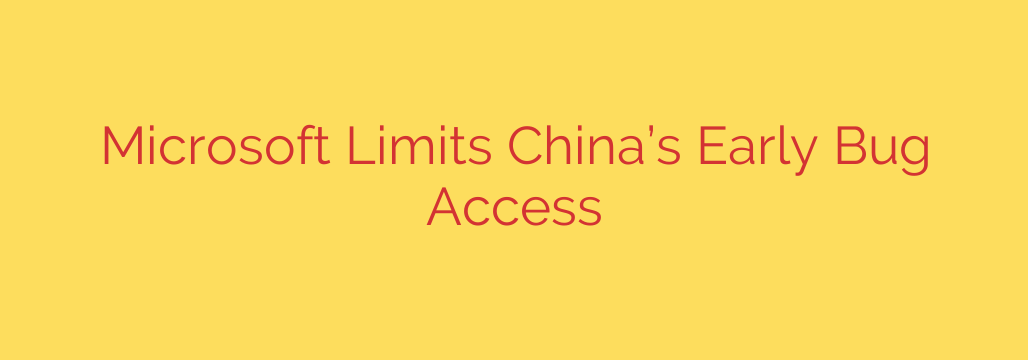
Microsoft Overhauls Security Program, Citing Geopolitical Risks
In a significant move reflecting the escalating tensions in cyberspace, Microsoft has adjusted its policy for sharing early information about software vulnerabilities. The change directly impacts how entities with ties to the Chinese government receive pre-release data on security flaws, highlighting a growing concern over the weaponization of this critical information.
This policy shift centers on the Microsoft Active Protections Program (MAPP), a long-standing initiative designed to bolster global cybersecurity. Through MAPP, Microsoft has traditionally provided trusted security partners with advanced details on vulnerabilities ahead of its public “Patch Tuesday” releases. This early access allows antivirus companies and other security vendors to prepare and deploy protections for their customers, creating a stronger defensive shield the moment a patch becomes available.
However, recent events have prompted a re-evaluation of this collaborative model. The core of the new policy is the restriction of access for organizations that are determined to have significant affiliations with the Chinese government. This decision is rooted in credible intelligence suggesting that early vulnerability data was being exploited by state-sponsored threat actors before official patches could be widely deployed.
The Risk of Weaponized Intelligence
The primary concern is that advance notice of a security flaw, intended for defensive purposes, can be reverse-engineered to create a functional exploit. For a sophisticated state-backed hacking group, this information is a goldmine, providing a critical window to launch attacks against unpatched systems.
This isn’t a theoretical risk. The global cybersecurity community has observed instances where zero-day exploits, or attacks leveraging undisclosed vulnerabilities, have been deployed by groups with known links to nation-states. By limiting who gets this sensitive data and when, Microsoft aims to close a potential loophole that could arm attackers instead of empowering defenders.
This strategic change underscores a fundamental challenge in the modern threat landscape: the delicate balance between collaborative defense and operational security. While sharing threat intelligence is crucial for a collective defense, it becomes a liability when that intelligence falls into the wrong hands.
What This Means for Your Organization’s Security
Microsoft’s policy change is a high-level strategic maneuver, but it serves as a critical reminder for all organizations about the realities of modern cyber threats. Geopolitical factors now directly influence cybersecurity risks, and businesses must adapt their security posture accordingly. Here are several actionable steps to enhance your organization’s resilience:
Implement a Robust Patch Management Strategy: The time between a vulnerability’s disclosure and its active exploitation is shrinking. Your top priority should be to apply security patches, especially those released on Patch Tuesday, as quickly as possible. Automated patching systems are essential for reducing your exposure.
Adopt a Defense-in-Depth Approach: Do not rely on a single security tool. A layered security model—including firewalls, endpoint detection and response (EDR), email security gateways, and regular employee training—creates multiple barriers for attackers. If one layer fails, others are there to stop the breach.
Prioritize Threat Intelligence: Stay informed about the tactics, techniques, and procedures (TTPs) used by threat actors relevant to your industry and region. Understanding your adversary allows you to build more effective and targeted defenses.
Develop and Test an Incident Response Plan: It’s not a matter of if you will face a cyberattack, but when. Having a well-documented and practiced incident response plan ensures your team can act quickly and effectively to contain a threat, minimize damage, and recover operations.
Ultimately, Microsoft’s decision marks a pivotal moment in the intersection of big tech and international relations. It signals a more cautious and security-first approach to information sharing, forcing organizations everywhere to be more vigilant and self-reliant in the ongoing fight against sophisticated cyber threats.
Source: https://go.theregister.com/feed/www.theregister.com/2025/08/21/microsoft_cuts_chinas_early_access/








